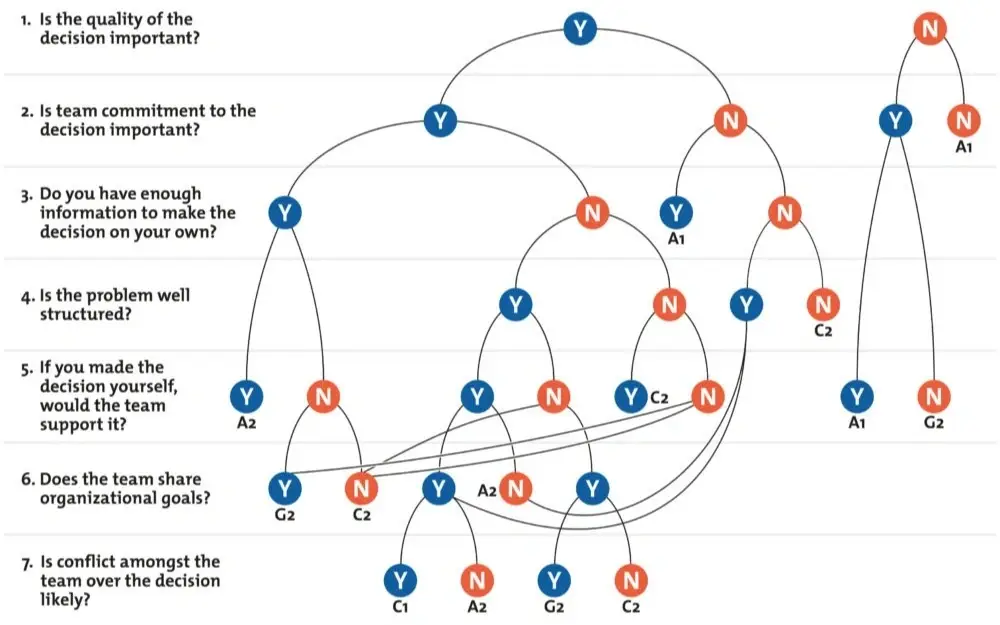A Guide to Decision Making | the Vroom-Yetton-Jago Normative Decision Model

There are lots of decisions you need to make in a typical week. But in a social-impact environment where the ethos may be consensus and collaboration, it can be hard to determine which decisions you can make on your own, and which require input from others. Luckily, we have a framework that will illuminate your way forward.
The Vroom-Yetton-Jago Normative Decision Model
It’s a mouthful, but once you get the hang of the concepts embedded in this streamlined model, you’ll have one more tool you can use to decipher which decisions can be made independently and which need a team. Developed by Victor Vroom and Phillip Yetton, with additional collaboration from Arthur Jago, this model dictates that you involve other people in the decision if one or more of these elements are present: a high-quality decision is critical, you need everyone to buy into the decision once it’s made, and you have sufficient time to involve others before you make the decision.
Imagine your decision making on a spectrum from the most solitary form (you decide alone) to the most engaging (you bring others in). The Vroom-Yetton-Jago Normative Decision Model offers five options:
- Autocratic I: Decide independently.
- Autocratic II: Gather basic additional information from others to inform your decision, and then decide independently.
- Consultative I: Share the details of your situation with a small number of others in order to gather high quality opinions, and then decide independently.
- Consultative II: Facilitate a group to generate ideas, share impressions and weigh in on the decision, and then make the decision independently.
- Collaborative: Facilitate a group toward a consensus decision without regard for your own opinions.
Four case studies in decision-making
The designers of this model gifted us with a handy visual tool we can use to walk through a short series of yes/no questions and arrive at the most appropriate decision-making method for the situation.

Let’s put it to work with a few examples of how you might use it at the office:
- You’re the primary organizer for your organization’s upcoming fundraising event, and you’ve run this event before. You’ve been asked by the catering team to make a decision on the color of the linens. Since one could argue that neither the quality of the decision or team buy-in are critical, you can use Autocratic I and make the decision independently.
- You’ve been invited to plan an upcoming retreat for your team of 12 in order to help new colleagues integrate into the group and get everyone focused on the same objectives. The quality of the decision and team commitment are both important. Yet you likely don’t have enough information to make the decision, nor is the problem well-structured. This would suggest you use either the Consultative II or Collaborative approach to make the decision.
- You’d like to make a procedural change to how your program is run, and the quality of the decision is important. You’d like others on your team to support what you decide, but you also know they’ll trust you to make the decision yourself. Using the visual guide, you learn that your best approach is Autocratic II. You gather basic input from the two other people who will have to make adjustments to their workflow and then you make the decision on your own.
- You have thoughts about strategic changes that could be made to your colleague’s program. Hold on! Common sense—and this decision-making model—both dictate that this is not your decision and you need to use the Collaborative method (or instead, share this model and your specific strategic idea with your colleague and let them decide).
One nuance of the model is that you’ll need to really lean into collaboration if you think the decision will be met with disagreement from the group. For those who tend to avoid conflict, it’s a nerve-wracking—though important—reminder of the need for consensus building. A second caution is that other decision-making tools might be more appropriate when a large group is involved (for that, you might look to the Constructive Controversy method instead).
Tying it all back to leadership
Why is this tool important to you as a leader? It gives one very concrete guide to help you decipher when to involve others in decision-making. Rather than simply relying on your gut or what someone else wants you to do, the Vroom-Yetton-Jago method can bring a lot more clarity and efficiency to your work. Take it out for a spin next time you’re faced with a decision that feels a bit complex and see what you learn!
Did you enjoy this post? There's plenty more where this came from! Subscribe here for updates.
Liz S. Peintner is a leadership coach and consultant based in Denver, Colorado who has spent her entire career in the social impact field. She helps people to better understand what drives them so they can choose careers they love and ultimately make positive social impact in ways that speak to their talents and passions.


